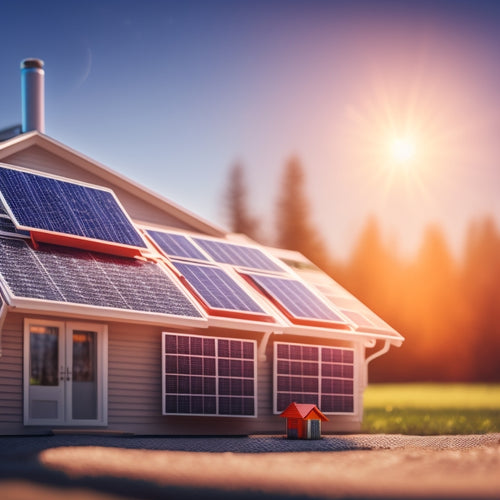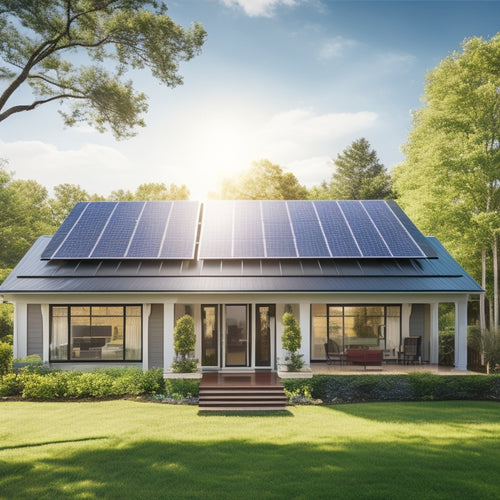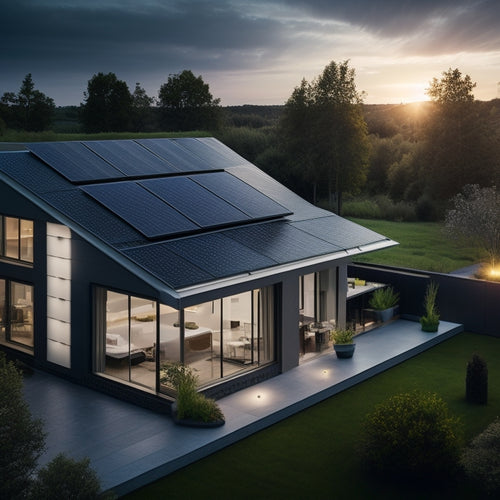
Self Install Home Solar System
Share
By installing a self-installed home solar system, you'll greatly reduce your electricity bills, saving hundreds or thousands annually. You'll also increase your property value by up to 17%, making it a smart investment for cost reduction and energy independence. Proper system sizing and maintenance are vital for meeting your energy needs and ensuring peak performance. Evaluating your roof's shading patterns and obstructions will help you optimize energy collection. With microinverters, you'll maximize energy output from each panel. As you take the first step towards utilizing clean energy, you'll uncover more ways to optimize your system's performance and reap its benefits.
The Essentials
- Self-installed solar systems provide control over energy use and significant long-term savings on electricity bills, potentially hundreds or thousands annually.
- Proper system sizing and maintenance are crucial for meeting energy needs, ensuring peak performance, and longevity of the solar system.
- Self-installation allows homeowners to take advantage of tax credits and other incentives that help offset installation costs and enhance overall savings.
- Solar energy is a clean, renewable source that mitigates climate change and enhances energy independence, reducing reliance on utility companies and rate hikes.
- With decreasing installation prices, self-installed solar systems have become a smart investment for cost reduction, increasing property value, and contributing to a sustainable future.
Save Money on Electricity
You'll greatly lower your electricity bill by utilizing free energy from the sun, reducing your reliance on the grid.
With a self-installed system, you'll not only cut energy costs but also gain greater control over your energy use and savings, much like having a Home Solar Battery that stores excess energy for later use.
By installing a home solar system, you'll cut energy costs and enjoy considerable savings over time.
With a self-installed system, you can expect to save hundreds, if not thousands, of dollars on your electricity expenses annually.
Lower Your Bill
Electricity costs can be a significant burden on your wallet, but utilizing the power of the sun can bring much-needed relief. By installing a home solar system, you can lower your electricity bill and enjoy significant savings.
In addition to saving money, switching to solar power also helps mitigate climate change and reduces your reliance on the grid, providing a sense of energy independence. The installation process is a vital step in harnessing the power of the sun, and with the right guidance, you can do it yourself.
During the installation process, you'll need to guarantee that your system is properly sized to meet your energy needs. This involves evaluating your energy usage and determining the number of solar panels required to generate sufficient power.
Proper system maintenance is also essential to guarantee peak performance and longevity of your system. Regular cleaning of solar panels and inverters, as well as monitoring system performance, will help you identify and address any issues promptly.
Cut Energy Costs
By utilizing the power of the sun, your wallet can reap considerable rewards. Installing a self-installed home solar system is a smart investment that can cut energy costs and increase energy efficiency.
With the rising cost of electricity, it's crucial to investigate alternative sources of energy that can reduce your reliance on the grid. By investing in a solar panel and battery package Renewable Energy Bundles, you can guarantee a reliable source of energy and reduce your energy bills.
Solar power is a clean and renewable source of energy that can greatly lower your electricity bills. By utilizing the sun's energy, you can generate free electricity and reduce your carbon footprint.
Additionally, solar incentives, such as tax credits and rebates, can help offset the initial cost of installation, making it a more affordable option.
Increases Property Value Fast
When you self-install a home solar system, you'll not only save on electricity costs but also enhance your property's resale value.
Since residential solar panel system installation prices have decreased over the years, it's now more affordable to invest in solar energy systems that can greatly reduce your energy bills.
In fact, a solar panel installation can increase your home's value by up to 17%, according to the National Renewable Energy Laboratory.
Boosts Real Estate Sales
Going solar can be a savvy move for homeowners looking to sell their property quickly and at a premium price.
You'll be catering to the growing demand for eco-friendly living, which is a major selling point in today's market.
Recent market trends show that buyers are willing to pay more for homes with solar panels, and it's not hard to see why.
Not only do they reduce your carbon footprint, but they also lead to significant savings on energy bills.
As a homeowner, you'll be capitalizing on buyer preferences for sustainable living and energy independence.
Increases Home's Resale Value
Installing a self-installed home solar system greatly increases your property's resale value, making it more attractive to potential buyers and setting it apart from comparable homes in the neighborhood.
By investing in this home improvement, you're not only reducing your carbon footprint but also enhancing your property's appeal to eco-conscious buyers. Energy efficiency is a top priority for many homebuyers, and a solar-powered home can be a major selling point.
In fact, studies have shown that homes with solar panels sell faster and for higher prices than those without. According to the National Renewable Energy Laboratory, homes with solar panels sell for up to $15,000 more than similar homes without them.
This is a significant return on investment, especially considering the cost of installing a solar system has decreased dramatically in recent years.
Microinverters Boost Energy Output
When you install microinverters in your self-installed home solar system, you'll experience optimized panel performance, as each panel operates independently to maximize energy production.
By integrating a reliable energy storage unit and a high-efficiency solar inverter, you can further enhance your system's overall performance and energy output.
This results in increased energy harvesting, even when some panels are partially shaded or affected by debris.
Optimized Panel Performance
Your solar panel system's energy output relies heavily on the performance of each individual panel, and microinverters play an important role in enhancing this performance. By guaranteeing each panel operates at its maximum potential, microinverters enable you to generate more energy from your solar array.
To enhance panel performance, it's vital to evaluate factors like panel orientation and installation angle, as these can greatly impact energy output. Weather conditions, such as shading and temperature, also affect performance, and microinverters can help mitigate these effects.
Inverter efficiency, maintenance practices, and energy storage all contribute to peak performance. System monitoring and performance analytics help you identify areas for improvement, while component compatibility guarantees seamless integration.
Increased Energy Harvesting
Microinverters are the vital component to unlocking your solar panel system's full energy-harvesting potential. By integrating them into your system, you can considerably enhance energy output and maximize your return on investment.
Traditional string inverters can't match the efficiency of microinverters, which optimize energy conversion at the individual panel level. This means that if one panel is underperforming, it won't drag down the entire system.
Microinverters employ advanced energy conversion technologies to guarantee maximum solar panel efficiency. They monitor and adjust energy production in real-time, allowing you to harvest more energy from your system.
This results in increased power output, reduced energy losses, and a shorter payback period for your investment. With microinverters, you'll enjoy a more reliable and efficient energy-harvesting system that's customized to your unique energy needs.
Assess Your Roof's Shading
You'll need to analyze your roof's obstructions, such as vents, skylights, and chimneys, to determine how they'll impact your solar panel system's performance.
Additionally, a thorough energy audit can help identify areas of energy inefficiency in your home, allowing you to optimize your solar panel system for maximum energy production.
Next, identify the shading patterns on your roof, considering factors like tree coverage, neighboring buildings, and roof angles.
Roof Obstructions Analysis
The roof's shading pattern greatly impacts the performance of a home solar system, making it vital to conduct a thorough roof obstructions analysis.
You'll need to assess your roof's pitch, installation orientation, and solar access to determine the ideal placement of your solar panels. Confirm your roof's structural integrity can support the weight of the panels and consider local regulations regarding installation.
Weather considerations, such as snow load and wind resistance, must also be factored in. Maintenance requirements, like panel cleaning and replacement, should influence your panel placement decisions.
A thorough shading analysis will help you identify areas where obstructions, like chimneys or skylights, may impact energy production.
When choosing a roof material, consider its compatibility with solar panels and potential impact on energy efficiency.
By carefully analyzing these factors, you'll be able to enhance your solar system's performance and achieve maximum energy independence.
Shading Pattern Identification
Shading patterns on your roof can markedly impact your solar system's energy production, making it essential to identify areas that receive shade throughout the day. To perform a shading analysis, observe your roof at different times of day, noting the shadows cast by trees, chimneys, vents, and other obstructions.
Take photos or create a sketch to document your findings. Pay close attention to the solar orientation of your roof, as south-facing surfaces receive the most sunlight. Identify areas that receive partial shade, as these can still generate some energy.
Consider using a solar pathfinder tool to visualize the sun's path across your roof throughout the year. When evaluating your roof's shading, consider the time of year and how the sun's position changes.
Note the duration and intensity of shading in each area, as this will impact your system's overall energy production. By understanding your roof's shading patterns, you can optimize your solar system's design and installation, ensuring maximum energy output and freedom from traditional energy sources.
Grid Independence Guaranteed Always
You're now in control of your energy production, generating power on your own terms.
With a self-installed home solar system, you're no longer reliant on the grid's whims, ensuring a consistent supply of clean energy.
You'll experience true energy independence, free from rate hikes and outages, as you capture the sun's power to fuel your daily life.
Energy On Your Terms
Frequently, homeowners find themselves at the mercy of their utility companies, subject to rate hikes and outages beyond their control.
But with a self-installed home solar system, you're taking back control. You're choosing energy on your terms. No longer will you be subject to the whims of your utility company. You'll be generating your own clean energy, reducing your reliance on the grid, and enjoying the solar installation benefits that come with it.
As you initiate your DIY solar expedition, you'll uncover the freedom that comes with energy independence. You'll no longer be held hostage by rate hikes and outages.
You'll be able to monitor and manage your energy usage with precision, making adjustments as needed to optimize your system's performance. With DIY solar tips and expert guidance, you'll be enabled to take control of your energy future.
You'll be generating clean energy, reducing your carbon footprint, and enjoying the satisfaction of knowing you're doing your part for the environment.
Take the first step towards energy on your terms – start planning your self-installed home solar system today.
Frequently Asked Questions
Can I Install Solar Panels on a Metal or Clay Tile Roof?
You can install solar panels on a metal roof, ensuring a secure metal roof installation with specialized clamps and flashing. However, clay tile considerations require extra care, as tiles may need to be removed and reinstalled to accommodate solar panel mounting.
Do Solar Panels Work During a Power Outage?
As darkness falls, and the grid goes dark, you wonder if your solar panels will keep shining; unfortunately, they won't, as they're designed to sync with the grid, not provide backup power during a power outage, leaving you in the dark.
Are Self-Install Solar Systems Eligible for Government Incentives?
You're eligible for government incentives, including tax credits, if you meet specific criteria, such as installing a solar panel system that meets local building codes and is certified by a qualifying third-party organization.
Can I Expand My Solar System in the Future if Needed?
As you plan for the future, you'll be relieved to know you can expand your solar system when needed; with compatible components, future upgrades are seamless, ensuring your investment remains flexible and efficient.
Do Solar Panels Require Regular Cleaning for Optimal Performance?
You'll want to prioritize solar panel maintenance, as dirty panels can reduce energy output by up to 25%. You should clean your panels every 6-12 months, depending on your location and climate, to guarantee peak performance and maximize your energy freedom.
Final Thoughts
You've finally decided to take the plunge and self-install a home solar system. Congratulations, you're about to join the ranks of the energy-independent! It's ironic that the very thing that's been draining your wallet - electricity - will soon be generating cash for you. With increased property value, enhanced energy output, and grid independence guaranteed, you'll be laughing all the way to the bank. So, go ahead, utilize that free energy and stick it to the utility companies!
Related Posts
-

A Beginner's Guide to Navigating the Solar Investment Tax Credit
You're eligible to claim a significant Solar Investment Tax Credit (ITC) of 30% of total installation costs, but mane...
-

Home Solar Installation Cost
You're considering installing solar panels on your home, and the upfront cost is likely the biggest hurdle standing i...
-

Home Solar Battery
You're opting for a home solar battery that allows you to utilize the power of the sun during the day and use it at n...


